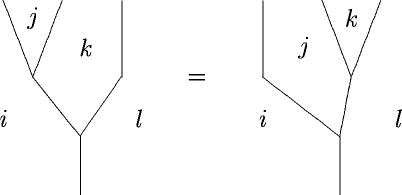Towards the FFRS Description of 2dCFT (B)
Posted by Urs Schreiber
More of our little seminar preparing us for the description of 2-dimensional conformal field theory in terms of “state sum models” internal to modular tensor categories.
Last time we had understood how to build representations of 2-dimensional cobordisms (called “2-dimensional quantum field theories”) by chopping these up into generators: the pair of pants, the cap, the co-pair of pants and the co-cap.
As we move up in dimension, and as we put extra structure on our cobordisms, it will become increasingly hard to find and handle a collection of such generators.
But: it will always be easy to chop any 2-dimensional cobordism into “2-generators”: little disk-shaped 2-dimensional pieces of our cobordism.
So we need to think about how to think about 2-processes that occur over such “2-generators”.
After doing, so, we rediscover the Frobenius property as an incarnation of the exchange law of 2-processes and see why we want to triangulate our cobordism and color the triangulation with a Frobenius algebra.

Secretly, this is all about expressing one 2-functor – one on the entire cobordism, say – in terms of another one # – living only over a little piece of cobordism.
This is possible if both are connected by a special ambidextrous adjunction: something weaker than an equivalence but stronger than an adjunction.
And special ambidextrous adjunctions are precisely what gives rise to special Frobenius monads.
And if we want to glue what we had sliced before, we need special Frobenius monads in ribbon categories.
And this is why we see special Frobenius algebras internal to ribbon categories decorating triangulations of surfaces.
The glue and the ribbon will appear in the next set of notes.

Re: Towards the FFRS Description of 2dCFT (B)
I did run badly out of time with preparing this. But here are some rough notes, for the moment: